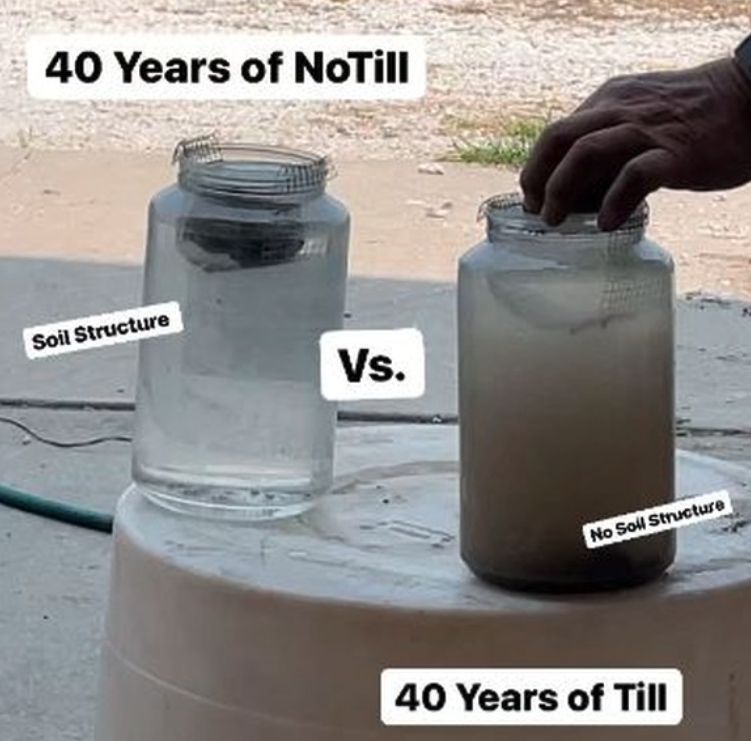
Water is life. If you don’t believe this, drink no liquid for a week and see how that turns out. We all depend on water for our existence, and water that is contaminated with potential toxins affects us all.
One of the major benefits of cover crops is that they can reduce agricultural-related pollution of our streams and rivers, through several different mechanism, such as:
- Increased rate of infiltration of rainfall, thus reduced runoff. Cover crops increase rainfall infiltration by creating surface residue (either living or dead), by providing root channels that water may enter into the soil, and by feeding soil organisms like earthworms and mycorrhizal fungi that improve soil porosity. If more water goes in the soil, less runs off, and there is less movement of agricultural chemicals or fertilizers from the soil surface. Phosphorus that runs off agricultural fields can cause populations of cyanobacteria (blue-green algae) to explode, and these organisms contain toxins that can cause illness or even be fatal if consumed. There is also reduced risk of flooding with cover crops. The water that leaves the farm field can create floods which can pick up pollutants that might be far away from the farm field and carry them downstream. An example might be when a city becomes flooded due to poor upstream water infiltration, and all the pollution from the city enters the water and moves downstream.
- Reduced soil erosion. One of the major pollutants in water is plain old soil. While soil is obviously natural and hardly considered toxic, it can cause major problems when it ends up in rivers and streams in excess quantities. Soil that runs off from agricultural fields can also be carrying fertilizer or pesticides that end up in bodies of water. This is not only problematic for the water, it is also an expense for the farmer that paid for those inputs and has lost them. Cover crops have a proven ability to reduce soil erosion. Soil that ends up in water is a problem for all of us, as sedimentation of reservoirs incurs dredging costs to maintain reservoir life that we all pay for through taxes.
- Reduced leaching of nitrate. Nitrate is a plant nutrient and is important for plant growth and crop yield. That is why more money is spent on nitrogen fertilizer than any other nutrient. But nitrate in drinking water can create toxicity issues and can even be fatal. Nitrate can leach down through soil profiles in rainy or irrigated areas, and once in groundwater it can end up in wells intended for drinking water use. Many areas in Nebraska have well with water containing several times the advisable level of nitrate for drinking water. Cover crops growing in the offseason between grain crops can sponge up left over nitrate after the harvest of the main crop and sequester it into organic forms of nitrogen that are not prone to leaching, and which can rot down into forms of nitrogen available to crops in future years.
- Reduced concentration of manure deposition. A high percentage of stream contamination in rural areas comes from having manure concentrated in winter feeding areas that are often next to creeks. The woodlands that often occur next to creeks make these areas a logical place for cattle to spend winter due to the wind protection they afford. But their proximity to water makes it easy for accumulated manure to wash into the streams. Cover crops can offer high quality forage during the winter and some cover crops, such as forage sorghum, can grow tall enough that they can provide wind protection as well. These feed sources can be established in areas far away from streams to minimize manure from entering watercourses.
A crop rotation that uses cover crops to maintain live roots and soil armor can greatly enhance water quality.
Cover Crops using the SmartMix Calculator
To help you quickly narrow the choices of cover crops for your situation, try our industry leading SmartMix Calculator.
This tool is based on
- The basic details of your field.
- The results you want to achieve.
- Crafting a custom seed mix that will achieve those results.
This article first appeared in our “Keepin’ You Covered” email newsletter where we share 1 soil health topic, 2 success stories and 3 learning opportunities.
If you’re excited to learn more, sign up for our bi-monthly newsletter here.
